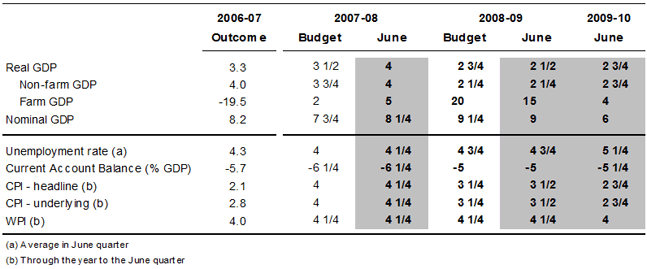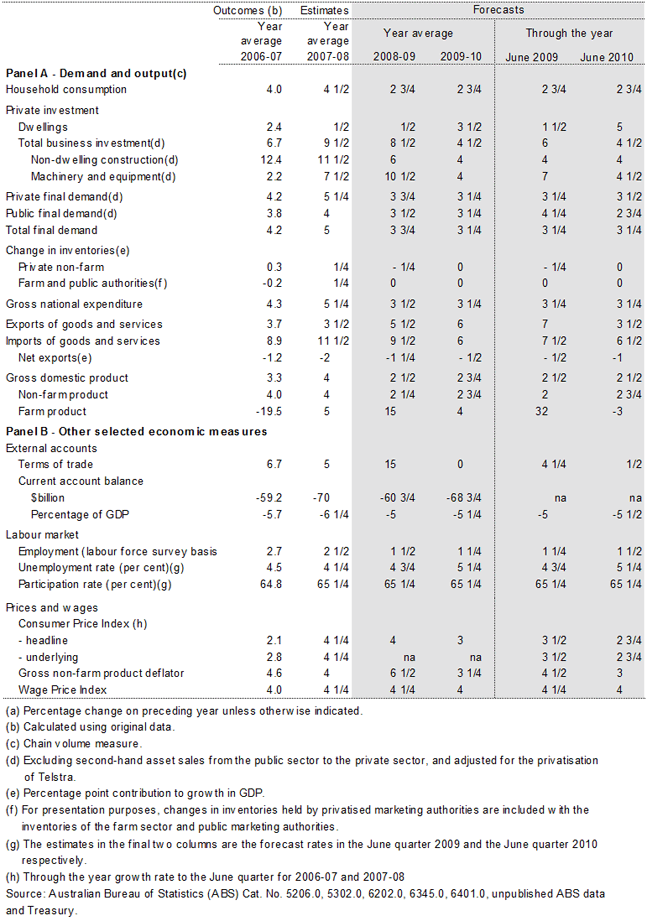As at Budget, Australian economic growth is forecast to moderate in 2008-09 under the weight of tighter monetary policy, continued global financial market strains and slowing world growth. Further out, growth is expected to remain restrained in 2009-10 as tight monetary policy settings remain in place to ease inflationary pressures. On the expenditure side, the easing is expected to be most pronounced for household consumption and dwelling investment. Indeed, growth in dwelling investment for 2008-09 has been revised down by 1½ percentage points to ½ a per cent since Budget.
The most striking development since Budget has been the rapid escalation in global oil prices, which have risen by around 15 per cent in Australian dollar terms from the assumptions underlying the Budget. Reflecting Australia's position as a net importer of oil, the higher prices are expected to offset some of the gains in the terms of trade which are now forecast to increase by 15 per cent in 2008-09, slightly lower than the Budget forecast of 16 per cent. The increase in oil prices more than offsets stronger iron ore export prices relative to Budget, which are now 85 per cent higher for the 2008-09 Japanese fiscal year. The terms of trade are assumed to remain flat in 2009-10, although there is considerable uncertainty as to the future direction of commodity prices.
Escalating world oil prices have also added to existing inflationary pressures, lifting our inflation forecasts by around ¼ percentage point through the forecast period. Headline CPI is now expected to grow by 4¼ per cent through the year to the June quarter 2008 and 3½ per cent to the June quarter 2009, before returning to the top of the RBA's target band in early 2010 as domestic demand growth eases.
The explosion at the natural gas production facilities at Varanus Island off Western Australia is expected to impact on the forecasts, reflecting increased imports of fuels to replace the lost supply, some interruption to non-rural commodities exports and some run-down in stocks. As a result of this incident, and the continued appreciation of the Australian dollar, net exports are now expected to subtract 1¼ percentage points from GDP growth in 2008-09, detracting ¼ percentage point more than at Budget.
Table 1: Key Domestic Forecasts - June Informal Round compared with Budget

Source: ABS Cat. No. 5206.0, 6345.0, 6401.0, 6202.0 and Treasury.
Employment growth is forecast to moderate in 2008-09 and 2009-10, consistent with an easing in non-farm GDP growth. In through the year terms, employment is forecast to grow by 2½ per cent to the June quarter 2008, before slowing to 1¼ per cent to the June quarter 2009 and 1½ per cent to the June quarter 2010. At the same time, the participation rate is expected to remain at around the record level of 65¼ per cent over the forecast horizon, supported by the high rates of participation from skilled immigrants. The unemployment rate is expected to reach 5¼ per cent by late 2009.
The CAD is expected to have peaked at 7 per cent of GDP in the March quarter 2008, and is forecast to narrow to 5 per cent of GDP in 2008-09 and 5¼ per cent of GDP in 2009-10. Small trade surpluses are expected in 2008-09 and 2009-10, partially offset by higher remittances of mining profits to foreign investors.
Conditions in the global economy always present risks to our domestic forecasts. Since Budget, concerns about global financial markets have lessened somewhat, but the impact of the recent credit crisis is still expected to dampen growth in the advanced economies in both 2008 and 2009.
Continued strength in commodity prices suggests that the terms of trade will be sustained at a high level in the foreseeable future, and further rises cannot be ruled out. However, sharp falls are also possible should there be a change in global supply conditions and/or a softening in demand from emerging markets, particularly China.
There are also significant risks around the inflation outlook. We have yet to see any sustained easing in oil prices and supply shortages in the housing market will continue to place upward pressure on rents. While wage outcomes have been contained and are expected to remain so over the forecast period, there is a risk that elevated inflation expectations will feed into higher wage claims and put further upward pressure on inflation.
Table 2: Domestic Economy Forecasts(a)
